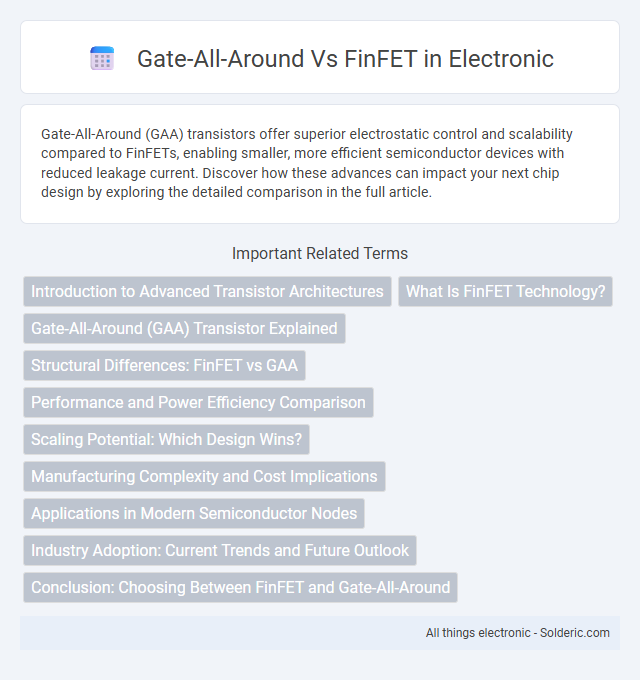Gate-All-Around (GAA) transistors offer superior electrostatic control and scalability compared to FinFETs, enabling smaller, more efficient semiconductor devices with reduced leakage current. Discover how these advances can impact your next chip design by exploring the detailed comparison in the full article.
Comparison Table
| Feature | Gate-All-Around (GAA) | FinFET |
|---|---|---|
| Structure | Channel surrounded by gate on all sides | Channel wrapped partially by fin-shaped gate |
| Gate Control | Excellent electrostatic control, reduces leakage | Good control, less effective than GAA |
| Scaling | Enables nodes beyond 3nm technology | Commonly used down to 5nm technology nodes |
| Performance | Better drive current and switching speed | High performance but limited by fin geometry |
| Manufacturing Complexity | Higher complexity and cost | Established process, lower complexity |
| Power Efficiency | Improved power efficiency due to better control | Good power efficiency, but higher leakage than GAA |
Introduction to Advanced Transistor Architectures
Gate-All-Around (GAA) transistors represent a cutting-edge evolution beyond FinFET technology, featuring a nanowire or nanosheet channel completely surrounded by the gate to enhance electrostatic control. This design significantly reduces short-channel effects and leakage currents compared to FinFETs, enabling improved performance and power efficiency in sub-5nm semiconductor nodes. Leading semiconductor manufacturers like TSMC and Samsung are adopting GAA architectures to overcome scaling limitations inherent in FinFETs for next-generation Integrated Circuits (ICs).
What Is FinFET Technology?
FinFET technology is a type of 3D transistor design that uses a vertical fin-shaped structure to improve control over the current flow, enhancing performance and reducing leakage compared to traditional planar transistors. It enables smaller, faster, and more power-efficient semiconductor devices by increasing the transistor's effective channel width while maintaining a compact footprint. Your choice between FinFET and Gate-All-Around technologies depends on specific performance, scaling needs, and manufacturing capabilities.
Gate-All-Around (GAA) Transistor Explained
Gate-All-Around (GAA) transistors represent the next evolution beyond FinFET technology, offering enhanced electrostatic control by fully surrounding the channel with the gate material. This architecture significantly reduces leakage current and short-channel effects, enabling improved power efficiency and scaling down to sub-3nm nodes. Your device performance benefits from the superior gate control and increased drive current density that GAA transistors provide, making them pivotal for advanced semiconductor manufacturing.
Structural Differences: FinFET vs GAA
Gate-All-Around (GAA) transistors feature a nanosheet or nanowire structure where the gate material surrounds the channel on all sides, providing superior electrostatic control compared to FinFETs. FinFETs have a three-dimensional "fin"-shaped channel with the gate wrapping around three sides, which limits gate control compared to the fully wrapped gate in GAA devices. Your choice between FinFET and GAA will impact device performance scalability, leakage control, and power efficiency due to these fundamental structural differences.
Performance and Power Efficiency Comparison
Gate-All-Around (GAA) transistors offer superior electrostatic control compared to FinFETs, resulting in enhanced performance with reduced leakage currents at smaller nodes. GAA designs enable lower supply voltages and improved subthreshold slope, significantly boosting power efficiency for high-density integrated circuits. Your choice of GAA technology can lead to faster switching speeds and longer battery life in advanced semiconductor devices.
Scaling Potential: Which Design Wins?
Gate-All-Around (GAA) transistors exhibit superior scaling potential compared to FinFETs due to their ability to provide better electrostatic control around the channel, significantly reducing short-channel effects at sub-5nm nodes. The GAA architecture enables uniform gate coverage on all sides of the channel, enhancing drive current and reducing leakage, which positions it as the leading technology for continued node scaling beyond 3nm. In contrast, FinFETs face physical limitations in fin height and spacing, restricting their effectiveness and making GAA the preferred choice for advanced semiconductor manufacturing processes.
Manufacturing Complexity and Cost Implications
Gate-All-Around (GAA) transistors offer superior electrostatic control compared to FinFETs, but their manufacturing complexity is significantly higher due to the need for precise nanosheet or nanowire stacking and advanced patterning techniques. This increased complexity leads to elevated fabrication costs, driven by additional process steps and tighter process control requirements. FinFETs remain more cost-effective for many applications due to their established, mature manufacturing ecosystem and lower defect rates.
Applications in Modern Semiconductor Nodes
Gate-All-Around (GAA) transistors offer superior electrostatic control over FinFETs, making them ideal for semiconductor nodes beyond 5nm where minimizing short-channel effects is critical. FinFETs dominate current 7nm and 5nm processes, powering high-performance CPUs and GPUs in smartphones and data centers, but GAA devices enable continued scaling at 3nm and below for enhanced energy efficiency and device density. Your choice between GAA and FinFET technologies impacts performance, power consumption, and integration complexity in next-generation integrated circuits.
Industry Adoption: Current Trends and Future Outlook
Gate-All-Around (GAA) transistors are rapidly gaining traction in semiconductor manufacturing due to their superior electrostatic control and scalability compared to FinFETs, which have dominated the industry for over a decade. Leading foundries like TSMC and Samsung are investing heavily in GAA technology for nodes beyond 3nm, signaling a shift towards increased industry adoption as challenges in FinFET scaling intensify. Your understanding of these trends is crucial for anticipating future developments, as GAA's improved performance and power efficiency promise to drive next-generation chips in advanced computing and mobile devices.
Conclusion: Choosing Between FinFET and Gate-All-Around
Gate-All-Around (GAA) transistors offer superior electrostatic control and scalability at sub-5nm nodes compared to FinFETs, enabling continued performance improvements and power efficiency in advanced semiconductor processes. FinFET technology remains highly effective for mature process nodes, delivering balanced performance and manufacturing cost advantages while supporting high volume production. Selecting between FinFET and GAA depends on target node, power-performance-area (PPA) goals, and fabrication complexity, with GAA favored for cutting-edge, low-power applications and FinFET preferred for cost-sensitive, established designs.
Gate-All-Around vs FinFET Infographic

 solderic.com
solderic.com